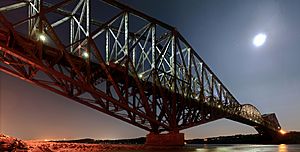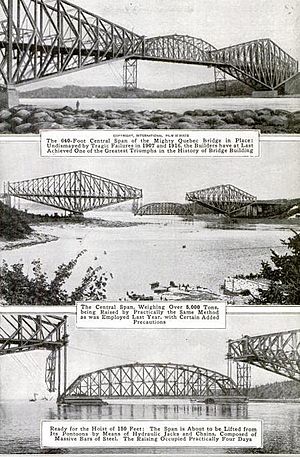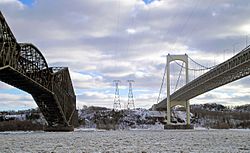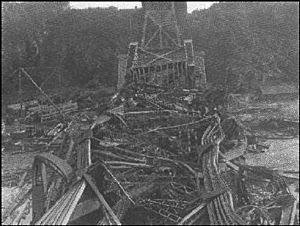Quebec Bridge facts for kids
Quick facts for kids Quebec BridgePont de Québec |
|
|---|---|

The Quebec bridge from the west side
|
|
| Coordinates | 46°44′46″N 71°17′16″W / 46.74611°N 71.28778°W |
| Carries | Route 175 Canadian National Railway and Via Rail 1 pedestrian walkway |
| Crosses | St. Lawrence River |
| Locale | Quebec City, and Lévis, Quebec |
| Owner | Canadian National Railway |
| Maintained by | Canadian National Railway |
| Preceded by | Pierre Laporte Bridge |
| Followed by | Île d'Orléans Bridge (partial crossing) |
| Characteristics | |
| Design | Cantilever bridge |
| Total length | 987 m (3,238 ft) |
| Width | 29 m (95 ft) wide |
| Longest span | 549 m (1,801 ft) |
| Clearance above | (?) |
| Clearance below | 46 m (151 ft) (high tide) |
| History | |
| Construction cost | $22 million (Approx. 350M$ in 2018) |
| Opened | December 3, 1919 |
| Statistics | |
| Toll | none since 1942 |
| Designated: | 1995 |
The Quebec Bridge (also called Pont de Québec in French) is a very important bridge in Quebec, Canada. It carries cars, trains, and people across the lower Saint Lawrence River. It connects Sainte-Foy (a part of Quebec City) with Lévis.
Building this bridge was very difficult. It failed twice while it was being built, once in 1907 and again in 1916. These accidents caused 88 people to lose their lives. It took over 30 years to finish the bridge, which finally opened in 1919.
The Quebec Bridge is made of riveted steel and has a special truss structure. It is 987 m (3,238 ft) long, 29 m (95 ft) wide, and 104 m (341 ft) high. It is a cantilever bridge, which means it has arms that stick out to support the middle section. Its main span is 549 m (1,801 ft) long. This makes it the longest cantilever bridge span in the world. For a while, it was the longest bridge of any type in the world. It is also the bridge farthest east that crosses the Saint Lawrence River.
Today, the bridge has three lanes for cars, one train track, and a walkway for people. It used to have two train tracks and even a streetcar line. Since 1993, the Canadian National Railway company has owned the bridge. In 1995, the Quebec Bridge was named a National Historic Site.
Contents
Why Was the Quebec Bridge Needed?
Before the Quebec Bridge was built, people had to cross the St. Lawrence River between Lévis and Quebec City by ferry. In winter, they could sometimes use an ice bridge when the river froze. People had been talking about building a bridge here since 1852.
Many people wanted a bridge to help travel and trade. Wilfrid Laurier, who later became Canada's Prime Minister, was a big supporter of the bridge project. He pushed for it from 1896 until he left office in 1911. People hoped the bridge would connect the two sides of the river better and help the economy grow.
First Bridge Design and Its Collapse in 1907
The Quebec Bridge was part of a big plan to build a railway across Canada called the National Transcontinental Railway. A company called the Quebec Bridge Company was created to build it. In 1903, the government agreed to help pay for the bridge.
The engineers in charge of the project made a big mistake. They did not properly check their early calculations for the bridge's design. This meant the bridge was much heavier than it should have been for its strength. The weight of the bridge itself, called the "dead load," was too much.
By the summer of 1907, as the bridge was almost finished, workers started to see parts of the steel structure bending. Norman McLure, an engineer on site, was very worried. He wrote to the main consulting engineer, Theodore Cooper, who at first thought the problems were small.
However, on August 27, it became clear that the bending was serious. McLure traveled to New York to meet Cooper on August 29, 1907. Cooper finally understood the danger and sent a telegram to the construction company, telling them not to add any more weight to the bridge.
But it was too late. That same afternoon, the south side of the bridge and part of the middle section suddenly fell into the St. Lawrence River. It collapsed in just 15 seconds. Out of 86 workers on the bridge that day, 75 were killed, and others were hurt. This was the worst bridge construction disaster in the world. Among those who died were 33 Mohawk steelworkers from the Kahnawake reserve.
After the collapse, a special group of engineers was formed to find out what happened. They found that the main reason for the failure was "errors in judgment" by two engineers: Theodore Cooper and Peter L. Szlapka, who designed the bridge parts. They also said that the bridge company made a mistake by not hiring a very experienced engineer to be in charge.
A popular story says that the metal from this collapsed bridge, which couldn't be used again, was melted down to make the first Iron Rings. These rings are worn by Canadian engineering graduates since 1925, reminding them of the importance of their work and its impact.
Second Bridge Design and Its Collapse in 1916
After the first disaster, a new team of engineers was chosen to design a second bridge. They included H. E. Vautelet, Maurice FitzMaurice, and Ralph Modjeski. The new design was much stronger and heavier.
On September 11, 1916, the bridge faced another tragedy. The large central part of the bridge was being lifted into place. But something went wrong with the lifting equipment, and the huge section fell into the river. This accident killed 13 workers.
Even though World War I was happening and steel was hard to get, construction started again very quickly. The government gave special permission for the bridge builders to get the steel they needed. The fallen central section of the bridge is still at the bottom of the river today.
After the bridge was finished in 1917, it was guarded by armed soldiers and police. People needed special passes to cross it until the end of the war.
Bridge Completion and Its Importance

The Quebec Bridge was finally finished in August 1919. The total cost was $23 million, and 88 workers had lost their lives during its construction. On December 3, 1919, the bridge opened for trains.
Its main span, which is 549 m (1,801 ft) long, is still the longest cantilever bridge span in the world. Finishing it was a huge achievement in engineering. In 1987, the Quebec Bridge was named an International Historic Civil Engineering Landmark.
What Happened After the Bridge Was Built?

The bridge was first built mainly for trains. But over the years, some of the train tracks and streetcar lines were changed. They became lanes for cars and a path for people to walk or bike. In 1970, the Pierre Laporte Bridge opened nearby to carry more highway traffic.
On January 24, 1996, the Quebec Bridge was again recognized as a National Historic Site. It has also been shown on two Canadian postage stamps, in 1929 and 1995.
The bridge was originally part of a government-owned railway system. In 1993, the government sold this railway, including the Quebec Bridge, to the Canadian National Railway (CN) for one dollar. CN became a private company in 1995, so the bridge is now privately owned. Even though it's private, CN gets money from the government to help with repairs and upkeep.
Lessons Learned from the Disasters

The Quebec Bridge disasters taught engineers important lessons about how powerful their work is and how important it is to supervise projects correctly. Because of these events, groups for Professional Engineers were formed around 1925.
These groups set strict rules for engineers. To become a Professional Engineer, you must pass an exam on ethics, show good character, and have at least four years of experience working under a certified engineer. Engineers must also be registered in the province where they work. These rules help make sure that engineers build safe and strong structures.
On August 29, 2006, a year-long remembrance began at the Kahnawake Reserve for the 33 Mohawk men who died in the 1907 collapse. A year later, on August 29, 2007, special ceremonies were held. A concrete structure with the victims' names was put up on the Lévis side of the bridge. A steel model of the bridge was also unveiled in Kahnawake to remember those who were lost.
See also
 In Spanish: Puente de Quebec para niños
In Spanish: Puente de Quebec para niños





